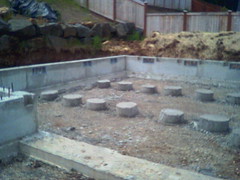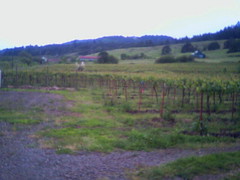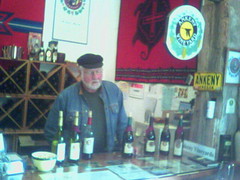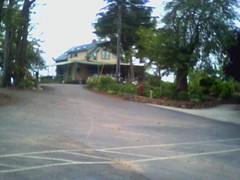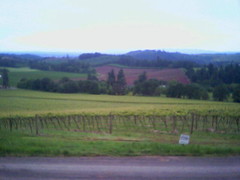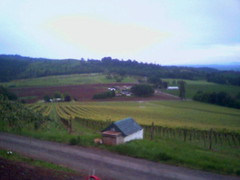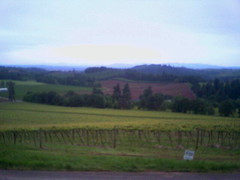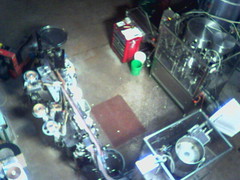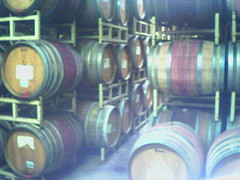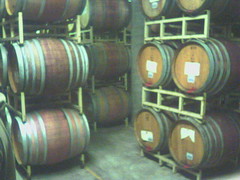Saturday was a lovely day. We got to the departure point and joined another baker's dozen of folks heading out for the day to see three different Oregon wineries and taste the products. About 10 am, we crammed into a large van and a small van and headed up the road. The trip north took about an hour and a quarter ("Are we there yet? Are we there yet?") to get to our first stop. We talked to a lovely couple, Jerry and Linda, who were fascinating people and a real pleasure to talk to.
The first winery was
Airlie Winery. The owner was a
very nice woman who spent a good deal of time explaining the brewing process for each of the wines, what made them special, and a lot of information about the grapes themselves, all of which was fascinating and informative stuff. I liked her but, sadly, I didn't like most of the wines she made. Part of the problem was that the whites didn't have enough perfume to the nose and the reds were all pretty raw and immature yet. Clearly some of the people liked them, though, so I figured that tastes differ and that's fine with me. We
did, however, really love a late harvest Gewürztraminer (aka "ice wine") and I bought a bottle of that.
One of the very interesting things that the owner of Airlie Winery showed us was the difference in flavors between wine aged in French oak vs. American oak. The latter tastes fairly strong and crisp with a slightly sweetish flavor. If you've ever had an oak floor sanded down, it's the same general aroma. French oak, on the other hand, has a smoother, rounder flavor with less sharp edges and a vanilla-y aroma. They're both nice flavors, but the French oak is more mature and more subtle than the American oak. (Funny, French and American oaks are just like… well, anyway.) She also showed us the barrel room, which is a beautiful and rather timeless place, filled with 55-gallon oak barrels tinged with red around the bung. There was a faint damp smell of oak and red wine, too.
Anyway, wine is usually aged in oak for between 10-16 months, after which it's bottled and aging continues. (Unlike scotches and bourbons, which only age as long as they're in the barrel; once they're bottled, the aging process stops.) French oak barrels--which cost about $850--are used maybe 4 or 5 times, after which they're sold to other wineries who are willing to use older barrels or they're sold, frequently as planters.
The owner told us that she had a music festival coming up Memorial Day weekend that the
Sawtooth Mountain Boys had been a feature of for the past 18 years. The event sounds wonderful and the locale (for which I sadly forgot to take any pictures) is worth the drive by itself. And who know? You might well have a different taste in wines than I (and you should definitely buy a bottle of the late harvest Gewürztraminer if you like a rich, fruity dessert wine), too.
We paused for whatever lunch we'd each packed for the trip at a picnic area at the Airlie Winery. Jerry and Linda very graciously offered us some of their lunch--they had packed heavily and we had packed light. It was quite sweet of them and they had wonderful vegetarian salads and a ciabatta bread that Linda had made the night before--yum!
We all rolled back into the vans and headed to the next winery, about a 40-minute trip. The most interesting part was taking a ferry ride on a small ferry across one point of the river. The ferry was on an overhead cable so that it just chugged back and forth. Passage for the van was $1.35 and the whole thing took about 5 minutes. Shortly thereafter, we pulled up to
Ankeny Vineyards.
The Ankeny Vineyards are very pretty and I actually remembered to start taking photos. (I am sure that everything would have looked better in sunlight, but this being Oregon, we got lots of gray skies and threatened rain on Saturday.)
The owner, Jim Olexa, is a friendly and rather colorful character who poured samples for us. As with Airlie Winery, we got to taste pinot gris, chardonnays, pinot noirs, and rieslings. I thought Jim's wines were a notch above the previous batch, but I also discovered that I just didn't care much for the pinot noirs that we were offered at either vineyard we'd been too so far: the taste is a little thin and sharp for me. I much prefer older zinfandels.
Here's a picture of the brewing area, which adjoins the tasting area. We didn't see the barrel room at this vineyard.
The house is surrounded by somewhat overgrown gardens with a combination of landscaping, unusual garden sculptures, and vegetables. There are also llamas and emus nearby--several signs pointed us off to where they were--but it was a bit of a walk, so we all decided to forego it.
Driving up to our last stop for the day, the
Willamette Valley Vineyards, we saw a much larger spread of cultivated land. The other two wineries had about 31 acres of land in cultivation, but Willamette Valley is
huge! The main buildings of the vineyard are up on a hill so you can see for a mile or two, as these pictures show. The buildings are wonderful and the facilities are frequently used for weddings, sometimes as many as 3 or 4 a day in the summer. (There was a wedding that was ending when we pulled into the parking lot.)
Actually, as our tour guide, Sally, explained, this whole area is an old volcanic cone, so the soil is very rich and there's a good valley for everything. The vineyard itself is on the south side of the cone, giving it the best exposure. Without this, there wouldn't be enough sun to grow good grapes in Oregon.
Once again, I was reminded why it is I love living here so much: the mountains make me feel safe and tell me where I am.
Sally took us into the processing area first. Willamette Valley is one of the few vineyards in the area that has its own bottling line, she said. Most of the others actually use the services of a mobile bottling line, where a truck drives up and you sorta pour the wine in the top, feed the labels in the side, and it spits the bottles out the back. Makes sense, really, as a bottling line is expensive to maintain below a certain level of production.
Having seen the bottling line from above and then from the floor, we walked over to the barrel room. The barrel room went on…
and on…
and on.
Barrels were stacked up three-high all over the place. Every barrel has a big, clear label that identifies everything there is to know about the wine it holds. And, like the other two vineyards, Willamette Valley only uses their barrels 4 or 5 times before retiring them.
We headed back upstairs to the tasting room. By this time, we'd had two vineyards under our belts and were just a wee bit tiddly already. We certainly weren't feeling below par. Sally poured a number of interesting wines for us. I was able to confirm that, yes, I don't usually care for pinot noir. However, Sally, did pour for us a
1999 pinot noir--everything we'd had so far was 2002 or 2003--and it was clear that a good deal of what I was objecting to was not necessarily pinot noir, but
immature pinot noir. This older bottle was much smoother, certainly less raw, and had a vastly improved flavor. I'll have to try a 10+ year old pinot sometime and see how that is.
Both the owner at
Airlie Winery and Sally had made reference to the movie
"Sideways", particularly with an eye towards the disparaging of cabernet franc. In fact, though, I rather like cabernet franc--better than most of the pinot noirs I'd had that day--and it was a pleasure to be tasting something a little different, too. They also served a petit syrah and a variety of scrumptious blended dessert wines (I'm a sucker for dessert wines).
In the end, we bought another 8 bottles of wine to add to the bottle of late harvest Gewürztraminer from Airlie Winery: two each of edelweiss (a sweet, blended wine with muscat, chardonnay, and Riesling), Oregon blossom (another sweet blend with a blush from some pinot noir; they described this as "the winery's answer to white zinfandel"), and a
2004 Riesling that has a great, light floral nose to it. But perhaps the best was the two bottles of a
a semi-sparkling muscat that has the rich, perfumy nose of
lychee fruit, which I'm very fond of in
lychee tea and
by itself. (My ex called lychees "
armored grapes," which I always have felt was a great description of them.)
Laden with bottles and boxes of bottles, we all crawled into the vans in a decidedly lubricated state and napped and nattered on the drive back to Eugene. The hour or so on the road gave us all a little time to de-fog so that we wouldn't be hazards on the road. Bidding each other goodbye at the starting point, we loaded our purchases and lunch containers into our cars and drove home, tired but happy from a very nice day out.

Vineyard trip--a little smashed and really smashing



